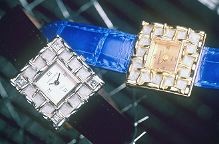Homepage
How To:
Technical
Guest Gallery:
Concrete Artists
Andrew Goss:
Concrete Work
Original Project
Concepts
Definitions
Other Ideas
Concrete Handbook
for Artists
SITE MAP

Other Connected Ideas:
Concrete, Art, Preciousness
THIS PAGE describes other interesting ideas about concrete, art and value that are connected to or run parallel with this particular project.
I welcome your input on the feedback page: either commenting on any of these ideas or adding new ones.
CONTENTS:Light Transmitting Concrete
Concrete Flutes
Concrete Cast House
Concrete Gold and Diamonds
Tadao Ando: Architect
Contemporary Concrete Floors
Money and Value
Light Transmitting Concrete
Inventor Aron Losonczi has developed a material called LiTraCon™. Using optical fibres imbedded in concrete, the blocks actually transmit light. Shadows cast on one surface of LiTraCon™ can be seen on the other side.
LiTraCon™'s web site, http://www.litracon.hu, shows several small wall installations, as well a a lamp made from the material.
From the web site:
LiTraCon™ offers the phenomena of light transmitting concrete in form of a widely applicable new building material. LiTraCon™ is a combination of optical fibres and fine concrete and can be produced as prefabricated building blocks and panels. Because of their small size the fibres blend into concrete becoming a component of the material like small pieces of aggregate.
Concrete Flutes
John W. Coltman, a U.S. physicist, recently demonstrated a concrete flute during a conference on music and human adaptation at Virginia Tech. With their eyes diverted, the attendees could not tell the difference between the concrete flute and a cherrywood one. The flutes were identical in all respects except for the material that enclosed the vibrating air column.
A Scientific American article on this subject makes an interesting observation:
But to many musicians, even a mountain of research remains unpersuasive. "We all know that wood flutes are much more dolce, much sweeter," says flutist Paula Robison. In contrast, "a gold flute sounds like an instrument made of gold. The silver flutes are much more perky."
And, as flutist James Galway points out, the workmanship of an instrument made of $70,000 worth of platinum is likely to be of extraordinarily high quality. "People pick up my flute and say, 'This is better.' Of course it's better; it's like getting into a custom-built motor car," he says.
So even though dozens of studies have been done proving Coltman's point, we bring with us beliefs about preciousness and rarity which are hard to give up and have little to do with the facts. Admittedly, the craftspeople working in platinum may be more skilled than those working in copper, but they may not be. The metal or rare woods have nothing to do with the quality of the sound. What is important is the design and workmanship, the exactness of the air column, the thickness of the walls and the shape of the tone holes.
In visual work, particularly jewellery, our associations with preciousness are more difficult to abandon, perhaps because a visual judgment is harder to make than one based on identical sound.
In response to this web site, Coltman emailed: "In my talk I made the same point that you did - we often think highly of something just because it is rare or expensive, ignoring its intrinsic merit. I often shake my head over the value placed on natural emeralds, a pretty poor gem, usually, and much inferior to synthetic gems having much better crystalline properties."
In Coltman's presentation comparing the concrete and cherrywood flutes he comments on:
the powerful psychological effect of association. Note that the preferred materials are often expensive or rare ones, and have qualities of visual or tactual beauty that are in themselves appealing. My concrete flute is not likely to have a large market, whatever its tonal qualities might be. We often prize things for their association, rather than for their intrinsic merit.
Concrete Cast House
In 1993 British artist Rachel Whiteread filled a house with white concrete from the inside. The Victorian terraced house in London's east end was then removed leaving the casting standing, showing the negative space as the object.
This is art using the inherent qualities of the material. A reviewer said of the object:
Denatured by transformation, things turn strange here. Fireplaces bulge outwards from the walls of House, doorknobs are rounded hollows. Architraves have become chiselled incisions running around the monument, forms as mysterious as the hieroglyphs on Egyptian tombs.The Independent
The project was controversial and was demolished in January of 1994. A book has been published by Phaidon Press on the subject: Rachel Whiteread - House (order info at amazon.com). Another book, Rachel Whiteread: Shedding Life (order info at amazon.com), discusses the house and other cast sculptural work. More on the project can be seen at http://www.tate.org.uk/britain/turnerprize/history/whiteread.htm.
Concrete Gold and Diamonds
Patrice Fabre, a Paris jeweller, exhibited jewellery in 1989 in a personal collection entitled Concrete, Gold and Diamonds. From the brochure:
Patrice Fabre has achieved this architectually inspired jewelry by marrying the most precious stone, diamond and the most common material of the century, concrete, with the symbolic standard of all time gold.
Patrice Fabre uses concrete in an innovative and unusual way by laying the concrete within a latticework of gold, highlighting this trellis effect by diamonds.
The result is a journey through tradition modernism and symbolism. Though this jewelry is linked to architecture, it could be described as sculpture. To us this juxtaposition of incongrous elements is a bold approach to precious jewelry and magnificent melange.

©Patrice Fabre. Watches: gold, diamonds, conrete. Another image?
The juxtaposition of these elements in jewellery design attempts to make the concrete precious, by relating it to architecture, and coupling it with gold and diamonds. But it does not question preciousness nor promote discussion on new ways of looking at what is valuable.
Tadao Ando: Architect
Concrete in architecture is not unusual, but Tadao Ando, Japan's leading contemporary architect, uses concrete for its own physical beauty and presence. Remarkably, Ando is a self-educated architect. His famous works include the Meditation Space at UNESCO in Paris, and the Forest of Tombs Museum in Kumamoto, Japan.
Web sites on Ando are disappointing, with few photographs, but this Pritzker Prize site is a good place for background information.
 However there are some marvellous books available. The paperback, Tadao Ando, by Philip Jodidio, Taschen (order info at amazon.com) and the large hardcover, Tadao Ando: The Colours of Light, by Richard Pare, Phaidon (order info at amazon.com) both have extensive and beautiful photographs.
However there are some marvellous books available. The paperback, Tadao Ando, by Philip Jodidio, Taschen (order info at amazon.com) and the large hardcover, Tadao Ando: The Colours of Light, by Richard Pare, Phaidon (order info at amazon.com) both have extensive and beautiful photographs.
Contemporary Concrete Floors
This is perfectly ordinary concrete -- emphasis on the perfect. But there's nothing plain about it. It is finished to within an inch of its life.
...Concrete can cost more than marble, up to $50 a square foot. It is like making a sidewalk out of silk.
"It's something prosaic made to look perfect," said Richard Gluckman, an architect with Gluckman Mayner Architects in New York...
Azzarone Contracting Corporation's president, Alan Bouknight, is quoted in the article:
"We're taking mud and making it beautiful," he said.
Concrete is being used now more and more within the home. This material revolution started with concrete countertops, helped along by the best selling book Concrete Countertops, by Fu-Tung Cheng with Eric Olsen. Cheng's next book, Concrete at Home, is the next book about indoor uses of concrete including floors, walls and fireplaces.
Money and Value
Since 1985 artist JSG Boggs has been creating likenesses for currencies -- American, British, Swiss, German, Australian -- in a variety of media. This new money is then used as currency, questioning our sense of what is valuable. Does the fake money have value because it resembles real money, or perhaps it has value as art?
...My subject matter is paper money. But at a deeper level it's a society's cultural approach to money- how people's behavior and thinking are reflected by the operation of these instruments.A web site for Boggs is at http://www.jsgboggs.com. The web site also discusses a long series of legal issues.
~Andrew Goss
CONTACT + LEGAL
Last update: January 19, 2006.